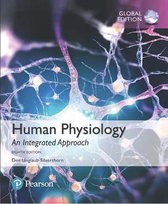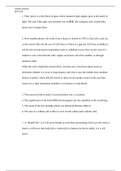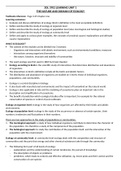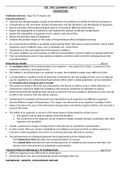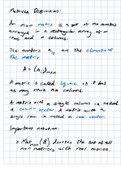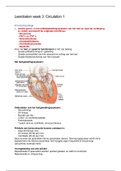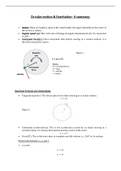Table of Contents
College 1 – Introductie fysiologie ...................................................................................... 2
Human Physiology: An Integrated Approach, Silverthorn, 8th edition ........................................ 4
College 2 – Zenuwstelsel: prikkelgedrag en neurotransmissie ............................................ 5
Human physiology 8.3 ................................................................................................................................. 12
College 3 – Autonoom zenuwstelsel ................................................................................ 18
Chapter 11 Efferent Division: Autonomic and somatic motor control ....................................... 25
College 4 en 5 – Zenuwstelsel: bouw en onderverdeling .................................................. 28
9.3 Anatomy of the central nervous system ............................................................................ 32
9.4 The spinal cord ................................................................................................................. 33
9.5 The brain.......................................................................................................................... 33
9.6 Brain function .................................................................................................................. 33
College 6 en 7 – Zenuwstelsel: zintuigen en perceptie ...................................................... 34
10.1 General properties of sensory systems ............................................................................ 39
10.2 Somatic senses ............................................................................................................... 41
10.3 Chemoreception: smell and taste .................................................................................... 42
10.4 The ear: hearing ............................................................................................................. 43
10.6 The eye and vision .......................................................................................................... 44
College 8 en 9 – Endocrinologie....................................................................................... 45
7.1 Hormones ........................................................................................................................ 45
7.3 Control of hormone release .............................................................................................. 46
College .................................................................................................................................. 46
College 10 t/m 12 – Huid en skelet; skeletsiperen ............................................................ 55
23.4 Bone growth requires adequate dietary calcium.............................................................. 55
12.1 Skeletal muscle............................................................................................................... 55
.............................................................................................................................................. 60
10.2 Somatic sense................................................................................................................. 61
College 10 – Huid en Skelet ............................................................................................. 61
College 11 en 12 – Skeletspieren ..................................................................................... 67
College 13 t/m 15 – Cardiovasculair systeem................................................................... 74
Leerstof .......................................................................................................................... 89
College 16 en 17 – Het respiratoire systeem .................................................................. 101
,College 16 en 17 – Respiratoir systeem ......................................................................... 108
College 18 – Regulatie van de spijsvertering ................................................................. 117
College 19 – Nieren ....................................................................................................... 124
19.1 The function of the kidneys ........................................................................................... 130
.................................................................................................................................................................. 132
19.6 Secretie .............................................................................................................................................. 134
19.7 Extractie ............................................................................................................................................ 134
College 20 en 21: Regulatie van de stofwisseling ........................................................... 134
22.2 Energy balance .................................................................................................................................. 144
22.3 Metaboslime ..................................................................................................................................... 144
22.4 Fed-state metabolisme ...................................................................................................................... 145
Practicum 1a: ............................................................................................................................................ 147
Practicum 1b ............................................................................................................................................. 150
Practicum 2a ............................................................................................................................................. 155
Practicum 2b ............................................................................................................................................. 160
Practicum 3 – Bio elektriciteit ................................................................................................................... 163
Practicum 4 – Zintuigen ............................................................................................................................ 165
Practicum 5 – Bloedonderzoek ................................................................................................................. 166
Practicum 6 – ECG en bloeddruk ............................................................................................................... 167
Practicum 7 – Schapenhart- en longen ..................................................................................................... 169
Practicum 8 – Ademhaling ........................................................................................................................ 173
Practicum 9 – ............................................................................................................................................ 173
College 1 – Introductie fysiologie
Leerdoelen:
- Begrijpen en kunnen uitleggen wat fysiologie is
- De relatie tussen morfologie en functie kunnen aantonen aan de hand van een aantal
voorbeelden
- Begrijpen en kunnen uitleggen wat homeostase is, en wat het belang is van
homeostase
- Begrijpen en beschrijven van belangrijke basismechanismen bij te instandhouding van
homeostase
Fysiologie = het bestuderen van biologisch functioneren.
Functie: waarom? Belang voor het organisme teleologische benadering
Mechanisme: hoe? Mechanistische benadering
Niveau's: molecuul - cel - weefsel - orgaan - orgaansysteem - organisme - populatie - ecosysteem.
Thematische indeling fysiologie
1. Structuur (morfologie) en functie (fysiologie)
2. Homeostase handhaaft stabiliteit intern milieu
3. Informatieuitwisseling noodzakelijk voor coördinatie lichaamsfucnties. Kan van het ene deel naar
het andere deel van het lichaam of naar naastliggende cellen.
4. Levende organismen hebben energie nodig
5. (Evolutie)
,Longen
Morfologie: vertakking van luchtwegen, uitkomend in longblaasjes. Groot oppervlak zodat meer
ruimte is voor uitwisseling, 100-150 m2. Daaromheen een hecht netwerk van capillairen.
Functie: fysiologie volume en capaciteit, gasuitwisseling, regulatie van de ademhaling.
Homeostase: het vermogen om relatief stabiele inwendige omstandigheden in stand te houden
ondanks voortdurende veranderingen in de omgeving. Ontdekt door Claude Bernard. 'The body
monitors its internal state and takes action to correct disruptions that threaten its normal function.
Stabiliteit in een open omgeving vereist mechanismen die deze stabiliteit kunnen handhaven. Een
stabiele situatie vereist dat elke (neiging tot) verandering wordt gevolgd door factoren die deze
verandering tegengaan. Homeostase ontstaat niet door toeval, maar is een gestuurd proces.
Homeostase is niet equilibirum (niet persé gelijk). Intracellulair is niet altijd gelijk aan extracellulair.
Deze verschillen zijn essentieel voor het functioneren van de cel.
Negatieve feedback: het lichaam reageert op een
verandering door die verandering terug te draaien
waardoor het interne milieu z'n normale waarde (set
point) zal behouden
Positieve feedback: het lichaam reageert op een
verandering door die verandering te versterken.
Meeste systemen zijn gereguleerd middels negatieve
feedback. Het is een toestand van dynamische
stabiliteit. Feedback loops vereisen communicatie
tussen integratie centrum (hersenen) en de overige
organen.
Intercellulaire communicatie
• Via elektrische signalen en lokale afgifte van neurotransmitters --> zenuwstelsel
• Via boodschappers in de bloedcirculatie --> hormonen (endocrinologie)
Neuraal - zenuwstelsel: doordat je gaat staan wordt je bloeddruk lager. Halsslagader zitten sensoren
die daling bloeddruk meten. Signaal van de hersenstam naar het hart voor een hogere bloeddruk.
Endocrien - hormoonstelsel: eten verhoogd bloeddruk --> beta cellen in eilandjes van Langerhans
maakt insuline aan --> cellulaire opname van glucose
, Human Physiology: An Integrated Approach, Silverthorn, 8th edition
Functie = waarom, theologische benadering.
Mechanisme = hoe
Thema 1: structuur en functie
Interacties tussen eiwitten, water en andere moleculen beïnvloeden de celstructuur en werking van
de cellen. Moleculen kunnen binden en reageren op andere moleculen dit is essentieel voor de
biologische functie. De functie is afhankelijk van de structuur en vorm.
Thema 2: levende organismen hebben energie nodig
Thema 3: Informatie- uitwisseling
Op het level van het organisme is dit DNA-translatie. Informatie-uitwisseling tussen cellen
coördineert de functie. Voor cel tot cel wordt gebruik gemaakt van chemische signalen, elektrische
signalen of beide.
Thema 4: Homeostase
Regulatie van de interne omgeving is belangrijk in de fysiologie.
Pathophysiology: study of body functions in a disease state. Very common is diabetes mellitus.
Extracellulair fluid (ECF) serves as transition between an organism's external environment and the
intraellulair fluid (ICF) inside cells.
Law of mass balance says that if the amount of substance in the body is to remain constant, any gain
must be offset by an equal loss. Total amount of substance x in the body = intake + production -
excretion - metabolism to a new substance.
Excretion is the elimination of material from the body, usually through the urine, feces, lungs, or
skin. Another option to keep mass balance is to convert the substance to a different substance
through metabolism.
Mass flow = concentration of x X volume flow
50g glucose per L X 2 mL solution/min = 0.1 g glucose/min.
Clearance = the rate at which the substance disappears from the blood.
More difficult to follow what is taking place in the intracellular fluid compartment. Intracellular fluid
has more K+ and ECF more Na+ and Cl-. Local control initiates the response and is short-distance.
Reflex control uses long-distance signaling. Response loop has three components: input, integrating
center and output signal.
Stimulus - sensor - input signal - integrating center(usually part of the nervous system) - output
signal (chemical signals) - target - response. Local control is restricted to a tissue. Reflex control uses
long-distance signaling.
Most function that maintains homeostasis have a setpoint, or normal value. Negative feedback loops
can restore the normal state but cannot prevent the initial disturbance.

